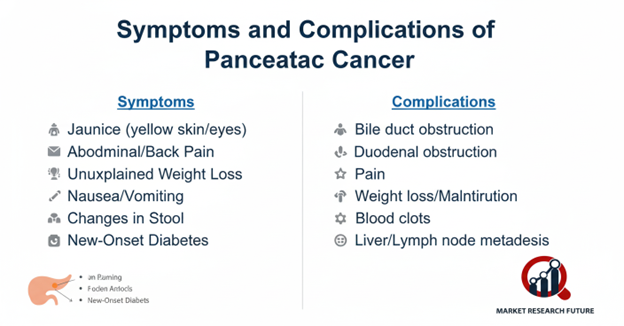Symptoms and Complications of Pancreatic Cancer

Pancreatic Cancer Market Overview
The pancreas is a vital organ located behind the lower part of the stomach. It plays a crucial role in digestion by releasing enzymes that break down food and in regulating blood sugar levels through hormone production. However, when abnormal cellular changes occur within pancreatic tissues, they can lead to pancreatic cancer—one of the most aggressive and rapidly spreading forms of cancer.
Pancreatic cancer is often diagnosed at an advanced stage due to the absence of early symptoms and the deep location of the pancreas, making detection challenging. Although the exact cause remains unclear, several risk factors—such as smoking, obesity, chronic pancreatitis, diabetes, and family history—are strongly associated with the disease.
Symptoms of Pancreatic Cancer
Pancreatic cancer often progresses silently in its early stages, with symptoms becoming apparent only as the disease advances. Common signs and symptoms include:
- Abdominal Pain: Persistent pain that may radiate to the back, often worsening after meals or when lying down.
- Jaundice: Yellowing of the skin and eyes caused by blockage of the bile duct.
- Light-Colored Stools and Dark Urine: Resulting from impaired bile flow.
- Itchy Skin: Often associated with jaundice.
- Fatigue: Generalized weakness due to cancer-related metabolic changes.
- Loss of Appetite and Unintended Weight Loss: A common early indication of cancer progression.
- New or Worsening Diabetes: Tumor-induced changes in insulin production can trigger sudden onset or poor control of diabetes.
These symptoms are often non-specific, which contributes to delayed diagnosis and treatment.
Complications of Pancreatic Cancer
As the disease advances, it may lead to several complications that affect quality of life and overall health. The most common complications include:
1. Weight Loss
Weight loss in pancreatic cancer patients is typically multifactorial. Cancer cells consume a significant portion of the body’s energy reserves, leading to fatigue and muscle wasting. Tumor growth can compress the stomach, causing nausea, vomiting, and difficulty eating. Additionally, pancreatic insufficiency impairs the digestion and absorption of nutrients, as the pancreas may no longer produce adequate digestive enzymes.
2. Jaundice
Jaundice occurs when the tumor blocks the liver’s bile duct, preventing bile from draining properly. This results in pale stools, dark urine, and yellow discoloration of the skin and eyes. In such cases, doctors may recommend inserting a stent—a small plastic or metal tube—to open the blocked duct and restore bile flow. The procedure, known as endoscopic retrograde cholangiopancreatography (ERCP), involves using an endoscope to access the bile ducts and inject contrast dye for imaging and treatment.
3. Pain
As pancreatic cancer progresses, tumor growth can press on nerves in the abdomen, leading to severe pain. Pain management typically involves medications, but in advanced cases, doctors may suggest nerve block procedures where alcohol is injected into the affected nerves to stop pain signals from reaching the brain. Treatments such as chemotherapy and radiation therapy may also help shrink tumors and reduce pain intensity.
Conclusion
Pancreatic cancer remains one of the most challenging cancers to detect and treat due to its silent progression and aggressive nature. Early detection significantly improves outcomes, with surgical procedures such as pancreatectomy or the Whipple procedure offering potential curative options in localized cases.
Comprehensive management—including early diagnosis, nutritional support, pain control, and advanced surgical and therapeutic interventions—is key to improving patient survival and quality of life.
As medical research continues to advance, a deeper understanding of genetic and molecular mechanisms may pave the way for earlier detection methods and more effective treatment strategies in the future.

Leave a Comment